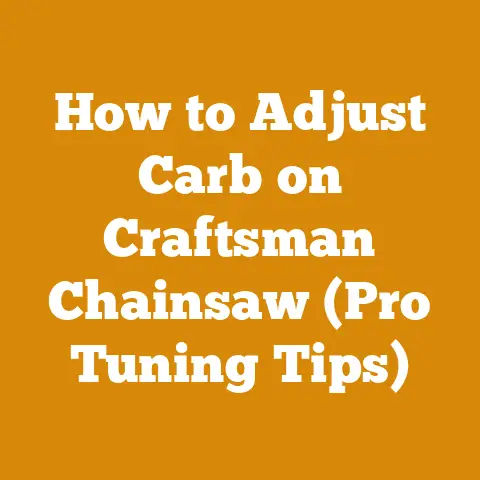Vermeer 1600 Wood Chipper Guide (5 Pro Tips for Efficient Use)
“Aha!” I remember the day I wrestled with a mountain of unruly branches after a storm, the frustration building with each tangled limb.
It was then I realized the true value of a reliable wood chipper.
Not just for cleanup, but for resource management and transforming waste into something useful.
The Vermeer 1600 wood chipper, in particular, stands out.
It’s a workhorse.
Over the years, I’ve learned a few tricks to maximize its efficiency and lifespan.
Let me share my insights with you in this guide, packed with pro tips for getting the most out of your Vermeer 1600.
Vermeer 1600 Wood Chipper Guide: 5 Pro Tips for Efficient Use
This guide isn’t just about operating a machine.
It’s about understanding the nuances of wood chipping, optimizing your workflow, and ensuring safety.
I’ll walk you through everything from preparing your materials to maintaining your chipper, all based on my years of experience in the field.
1. Prepping for Success: Material Handling and Sorting
Before you even think about firing up the Vermeer 1600, proper material preparation is key.
This isn’t just about saving time; it’s about preventing jams, reducing wear and tear on your machine, and creating a more uniform chip.
Sorting Your Wood: A Critical First Step
Not all wood is created equal.
Different types of wood chip differently, and some materials shouldn’t be chipped at all.
- Hardwoods vs.
Softwoods: Hardwoods like oak and maple are denser and require more power to chip than softwoods like pine and fir.
Segregate these to adjust your chipper’s feed rate accordingly. - Green vs.
Dry Wood: Green wood is easier to chip but produces wetter chips that are prone to composting if not managed properly.
Dry wood can be harder on the blades but yields drier, more stable chips. - Contaminants: Rocks, metal, and plastic are the enemy of any wood chipper.
Thoroughly inspect your material and remove any foreign objects.
I once spent an entire afternoon disassembling a chipper because someone accidentally fed a piece of rebar through it.
Learn from my mistake! - Branch Size and Shape: The Vermeer 1600 has a maximum chipping diameter.
Don’t exceed it.
Also, be mindful of forked branches or oddly shaped pieces.
These can get caught and cause jams.
Optimizing Material Size and Presentation
How you present the wood to the chipper makes a huge difference.
- Limbing: Remove as many small branches as possible.
This reduces tangling and makes it easier to feed the material. - Butt End First: Always feed the butt end (the thicker end) of the branch into the chipper.
This allows the blades to gradually shave off material instead of trying to grab the entire branch at once. - Consistent Feeding: Maintain a steady, consistent feed rate.
Avoid shoving large amounts of material in at once, as this can overload the machine. - Pre-Cutting: For larger branches, consider pre-cutting them into manageable lengths.
This not only makes them easier to handle but also reduces the strain on the chipper.
Case Study: The Pine Plantation Project
I worked on a project clearing a pine plantation that had been ravaged by pine beetles.
The sheer volume of dead trees was overwhelming.
By implementing a strict sorting and pre-cutting protocol, we were able to significantly increase our chipping efficiency.
We separated the larger trunks for milling and chipped the smaller branches and tops.
This approach not only sped up the process but also allowed us to repurpose the wood for different applications.
Takeaway: Proper material preparation is not just about convenience; it’s about protecting your investment and maximizing your output.
2. Mastering the Feed System: Optimizing Input for Output
The feed system of the Vermeer 1600 is designed to efficiently draw material into the chipping drum.
However, it’s crucial to understand how to optimize its performance.
Understanding the Feed Rollers
The feed rollers are responsible for gripping and pulling the wood into the chipper.
- Adjusting Roller Pressure: The pressure of the feed rollers can be adjusted to accommodate different types of wood.
Softer woods require less pressure, while hardwoods require more.
Consult your operator’s manual for the correct settings. - Roller Maintenance: Keep the rollers clean and free of debris.
Dirty rollers can lose their grip, leading to slippage and reduced feeding efficiency.
Regularly inspect them for wear and tear and replace them as needed.
Utilizing the Infeed Table
The infeed table provides a platform for staging material before it enters the chipper.
- Proper Loading: Load the infeed table in a way that allows the material to flow smoothly into the feed rollers.
Avoid creating piles or obstructions that can impede the flow. - Using the Infeed Table as a Sorting Area: The infeed table can also be used as a temporary sorting area.
This allows you to quickly remove any contaminants or oversized pieces before they reach the chipper.
Feed Rate Control: Finding the Sweet Spot
The feed rate control allows you to adjust the speed at which the feed rollers pull material into the chipper.
- Matching Feed Rate to Material: The ideal feed rate depends on the type and size of the material being chipped.
Start with a slower feed rate and gradually increase it until you find the sweet spot where the chipper is working efficiently without bogging down. - Listen to the Machine: Pay attention to the sound of the chipper.
If it starts to bog down or vibrate excessively, reduce the feed rate. - Avoid Overfeeding: Overfeeding the chipper can lead to jams, blade damage, and reduced fuel efficiency.
It’s better to feed the material at a consistent rate than to try to force too much through at once.
My Personal Experience: The Overambitious Operator
I once worked with an operator who was convinced he could chip anything at any speed.
He constantly overfed the chipper, causing frequent jams and putting undue stress on the machine.
After several costly repairs, he finally learned the importance of respecting the machine’s limits.
Takeaway: Mastering the feed system is about finding the right balance between speed and efficiency.
Listen to your machine, adjust your settings accordingly, and avoid the temptation to push it beyond its capabilities.
3. Blade Maintenance: The Sharpest Tool in the Shed
The blades are the heart of any wood chipper.
Keeping them sharp and properly maintained is essential for optimal performance and chip quality.
Understanding Blade Types and Sharpening Techniques
The Vermeer 1600 typically uses hardened steel blades.
- Blade Inspection: Regularly inspect your blades for chips, cracks, or excessive wear.
Dull or damaged blades not only reduce chipping efficiency but also increase the risk of kickback. - Sharpening Frequency: The frequency of sharpening depends on the type of wood you’re chipping and the amount of use the blades get.
As a general rule, sharpen your blades after every 8-10 hours of use. - Sharpening Methods: Blades can be sharpened using a bench grinder or a specialized blade sharpener.
Follow the manufacturer’s instructions for the correct sharpening angle and technique. - Professional Sharpening: If you’re not comfortable sharpening your own blades, consider taking them to a professional sharpening service.
They have the expertise and equipment to ensure that your blades are properly sharpened and balanced.
Blade Replacement: Knowing When to Call It Quits
Even with proper maintenance, blades eventually wear out and need to be replaced.
- Wear Indicators: Look for signs of excessive wear, such as thinning blades or rounded edges.
- Cracks and Chips: Replace any blade that has cracks or chips, regardless of its overall condition.
- Following the Manual: Consult your operator’s manual for the recommended blade replacement schedule.
- Using OEM Parts: Always use genuine Vermeer replacement blades.
Aftermarket blades may not meet the same quality standards and can damage your machine.
The “Dull Blade” Disaster: A Cautionary Tale
I once ignored the signs of dull blades, thinking I could squeeze a few more hours of use out of them.
The result was a significant decrease in chipping efficiency, increased fuel consumption, and a lot of frustration.
I learned the hard way that neglecting blade maintenance is a false economy.
Takeaway: Blade maintenance is not just about keeping your chipper running smoothly; it’s about ensuring safety and maximizing the lifespan of your machine.
Invest the time and effort to keep your blades sharp and properly maintained.
4. Hydraulic System Management: The Lifeblood of Your Chipper
The hydraulic system powers the feed rollers and other critical functions of the Vermeer 1600.
Proper maintenance of this system is essential for reliable operation.
Fluid Levels and Types
- Regular Checks: Regularly check the hydraulic fluid level and top it off as needed.
- OEM Fluids: Use the hydraulic fluid recommended by Vermeer.
Using the wrong type of fluid can damage the system. - Contamination: Keep the hydraulic fluid clean and free of contaminants.
Dirt and debris can clog the system and cause premature wear.
Filter Maintenance
- Regular Replacement: Hydraulic filters should be replaced regularly, typically every 250 hours of operation.
- Filter Inspection: Inspect the filters for signs of contamination.
If the filters are excessively dirty, it may indicate a problem with the hydraulic system.
Hose Inspection and Replacement
- Wear and Tear: Inspect hydraulic hoses for signs of wear and tear, such as cracks, abrasions, or leaks.
- Timely Replacement: Replace any hose that is damaged or showing signs of wear.
A burst hydraulic hose can be dangerous and can cause significant damage to the machine.
Case Study: The Leaky Hose Incident
I was working on a project when a hydraulic hose suddenly burst, spraying hydraulic fluid everywhere.
Fortunately, no one was injured, but the incident brought the project to a standstill.
It was a stark reminder of the importance of regular hose inspections and timely replacement.
Takeaway: The hydraulic system is the lifeblood of your Vermeer 1600.
By paying attention to fluid levels, filter maintenance, and hose inspections, you can prevent costly repairs and ensure reliable operation.
5. Safety First: Protecting Yourself and Others
Wood chipping can be a dangerous activity if proper safety precautions are not followed.
Personal Protective Equipment (PPE)
- Eye Protection: Always wear safety glasses or a face shield to protect your eyes from flying debris.
- Hearing Protection: Wear earplugs or earmuffs to protect your hearing from the loud noise of the chipper.
- Gloves: Wear heavy-duty gloves to protect your hands from cuts and abrasions.
- Appropriate Clothing: Wear long sleeves and long pants to protect your skin from scratches and splinters.
Avoid loose-fitting clothing that can get caught in the machine. - Steel-Toed Boots: Wear steel-toed boots to protect your feet from falling objects.
Safe Operating Procedures
- Read the Manual: Familiarize yourself with the operator’s manual and follow all safety instructions.
- Clear the Area: Clear the area around the chipper of any obstacles or bystanders.
- Never Reach Into the Infeed Hopper: Never reach into the infeed hopper while the chipper is running.
Use a push stick to feed the material into the rollers. - Emergency Stop: Know the location of the emergency stop button and how to use it.
- Lockout/Tagout: Before performing any maintenance or repairs, always lock out and tag out the machine to prevent accidental startup.
Communication and Awareness
- Spotter: If possible, have a spotter present to monitor the area and provide assistance.
- Clear Signals: Establish clear communication signals with your spotter.
- Be Aware of Your Surroundings: Pay attention to your surroundings and be aware of potential hazards.
The Near Miss: A Wake-Up Call
I once witnessed a near miss when a worker reached into the infeed hopper to clear a jam while the chipper was still running.
Fortunately, he was able to react quickly and avoid injury.
The incident served as a wake-up call for everyone on the crew and reinforced the importance of following safety procedures.
Takeaway: Safety is paramount when operating a wood chipper.
By wearing proper PPE, following safe operating procedures, and maintaining constant awareness, you can protect yourself and others from injury.
Never compromise on safety.
It’s not worth the risk.
Bonus Tip: Optimizing Chip Placement
Where the chips land is just as important as how they are produced.
- Controlled Discharge: Adjust the discharge chute to direct the chips where you want them.
Avoid spraying chips onto roads, sidewalks, or other areas where they could create a hazard. - Trailer Loading: When loading chips into a trailer, distribute the weight evenly to prevent tipping.
- Chip Storage: If you’re storing chips, choose a location that is well-drained and away from buildings or flammable materials.
Wet chips can spontaneously combust.
Final Thoughts
The Vermeer 1600 is a powerful and versatile machine that can greatly improve your wood processing efficiency.
By following these pro tips, you can maximize its performance, extend its lifespan, and ensure a safe and productive work environment.
Remember, wood chipping is a skill that requires practice and attention to detail.
Take the time to learn the nuances of your machine, and always prioritize safety.
Now, get out there and turn those branches into valuable wood chips!






